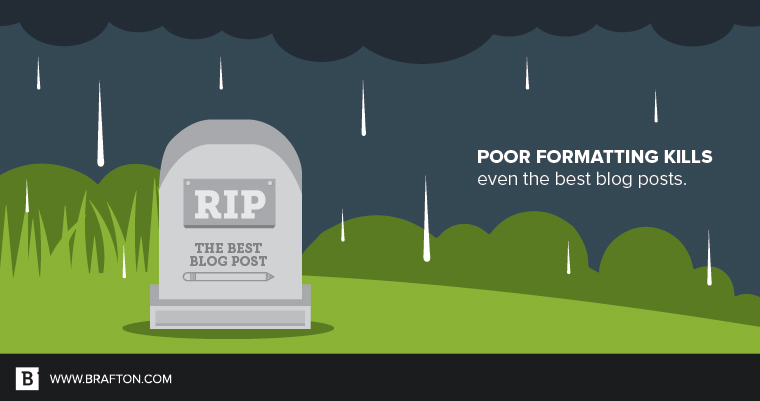Every piece of content marketing can support your commercial goals. Just as important, however, is understanding where different types of content fall in the sales funnel and how this impacts the lead generation strategies you should employ.
Do you recognize the role your blog plays in lead generation marketing?
Assists, not goals
While it’s certainly possible to score macro conversions from a blog post, it’s not likely.
“Too many marketers don’t understand what a blog is,” said Jeff Baker, Director of Digital Marketing Strategy at Brafton. “They’ll be asking for bottom-of-funnel results from a top-of-funnel asset.”
As we’ve written about before, blog posts reside at the very top of the sales funnel, working to engage prospective customers who are in the initial awareness stage. In fact, for many visitors, your blog is likely the first time they’ve ever heard of you.
Chances are these website visitors came across your blog with education in mind, not commerce. Trying to force the issue and turn a trust-building content asset into a sales pitch will do more harm than good. As Jeff said, “You can’t ask something to happen of an audience that isn’t ready to make something happen.”

Blogs tend to increase website bounce rates – visitors are likely to click away as soon as they obtain the information they need. In order to transform blog posts into lead generation tools, do what you can to encourage further travel down the sales funnel. Posts can assist in an eventual conversion if they keep visitors coming back and engaging with other content marketing assets.
“People are not going to work hard to get any further down the funnel themselves, so you have to make is as easy as humanly possible,” Jeff said. “If they’re not shopping, if they’re conducting an informational search – they’re not looking to be sold. However, if you put something in front of them that adds to their experience, and they don’t realize they’re going further down the funnel, they’ll click. Give, don’t take. They’re getting something valuable, and you’re getting them to commit just a little bit more.”
Your first step is stocking your content arsenal with the appropriate assets.
“You need content that gives visitors something and requires the least commitment necessary on their part.” – Jeff Baker, Director of Digital Marketing Strategy
“You have to create eBooks, webinars, infographics, white papers – middle-of-funnel content,” Jeff said. “Forget putting a ‘contact us’ form on a blog post. You need content that gives the visitor something and requires the least commitment necessary on their part.”
Access to these mid-funnel assets can be gated and used to capture lead information. This way, website visitors are rewarded for sharing their details.
Keep in mind that not all blog visitors are created equal, however.
“If someone clicks on a case study or success story in your blog, they’ve pre-qualified themselves as someone who may be interested in working with you,” Jeff continued. “If that’s the case, you must make sure the follow-up content matches the searcher’s intent. Custom calls-to-action that take them to product landing pages may make sense in that scenario.”
Painting a pretty picture
What you’re offering is all for nothing if it doesn’t come wrapped in the appropriate package. The actual web pages that make up your blog must be structured in such a way to encourage visitors to take the next step, whatever that may be.
First, trade in your text-based CTAs for the visual variety.
“Our attention spans are so short, and on the internet, attention is worth more than gold,” Jeff said. “Visuals will grab it and hold on to it in a way text can’t.”
Incorporate visual CTAs on your blog’s sidebar, as well as at the bottom or within blog posts.
Beyond CTAs, it’s vital to balance your text with imagery and other visual elements to keep visitors reading. Bulleted lists, pull quotes, H2 tags – all these and more will help break up walls of text and enable people to easily skip around a blog post to find the information they want. They’re also important for search engine optimization.

As far as images are concerned, remember that stock imagery is equated with stock content in the minds of modern consumers. Opt for custom imagery and videos to raise the bar on quality and better engage with blog visitors.
Also keep basic user experience factors in mind. Issues like hard-to-read fonts and overly wide columns may be relatively easy fixes, but they’ll drive potential customers away until you get them right.
“You can write the best blog post in the world, but it’ll never be read if it’s formatted poorly,” Jeff said.
Finally, trade in your subscription button for a pop-up window. While some see pop-ups as intrusive, there’s no denying they can turn your blog into a conversion-focused instrument.
“Pop-up windows convert much better than subscribe buttons,” Jeff said. “They puts things front and center, and usually give a bit more context about what it is a person’s getting. They dominate the page.”
Case in point: After implementing a pop-up form, Brafton’s newsletter subscriptions increased by 575 percent in two weeks.
But don’t take our word for it. Do your own testing to see what works for you. From blog layout to the topics you write about, it’s worth experimenting with your strategy to see what helps turn curious visitors into paying customers.





